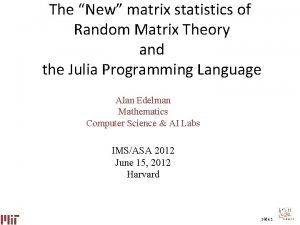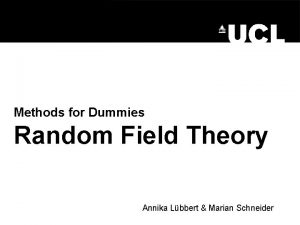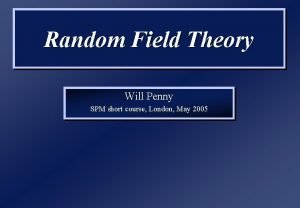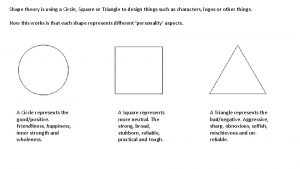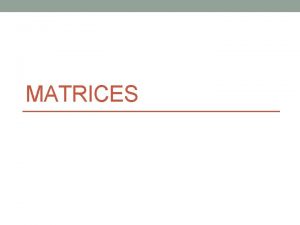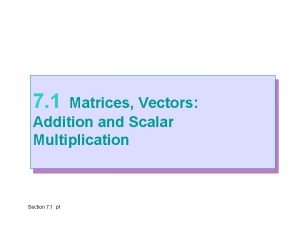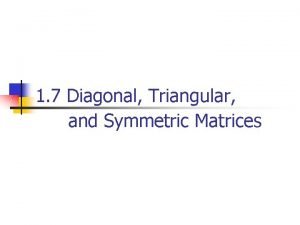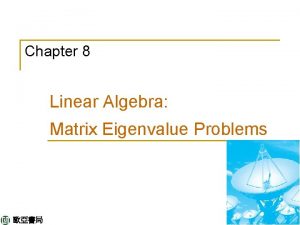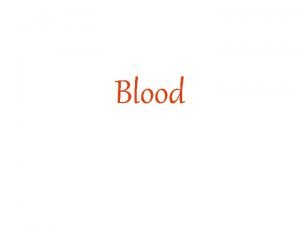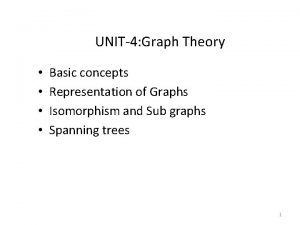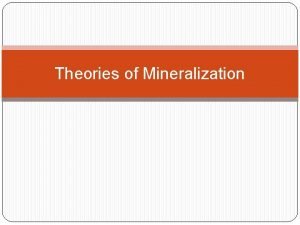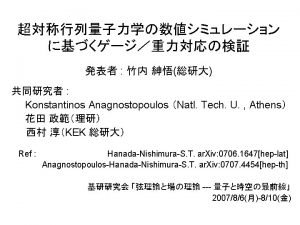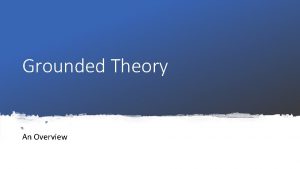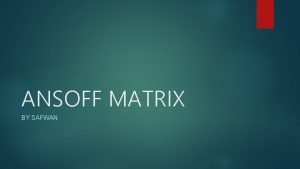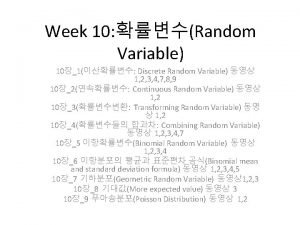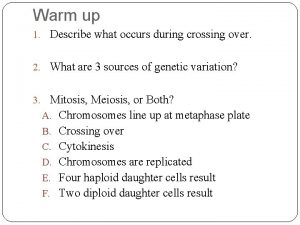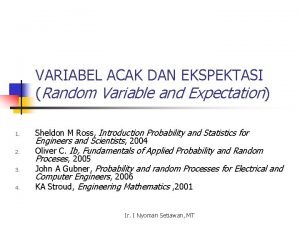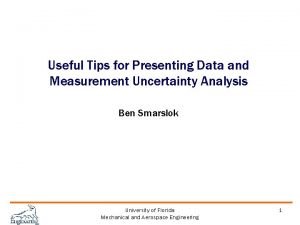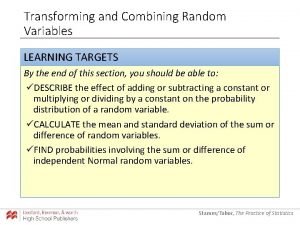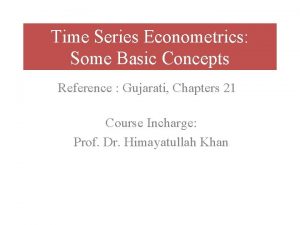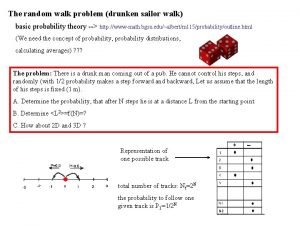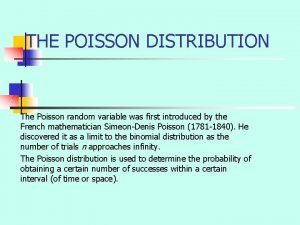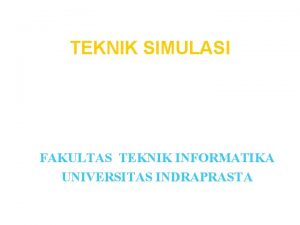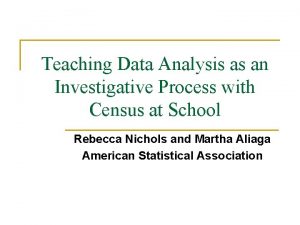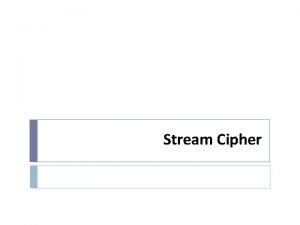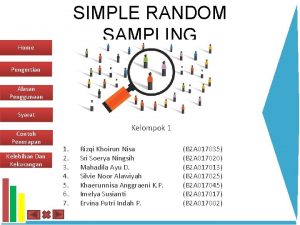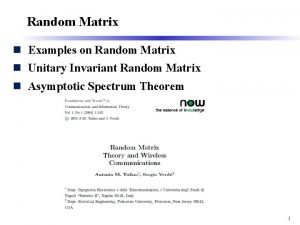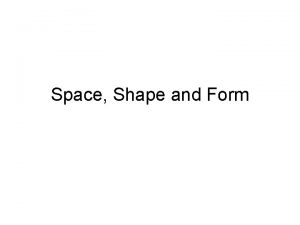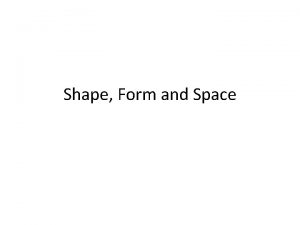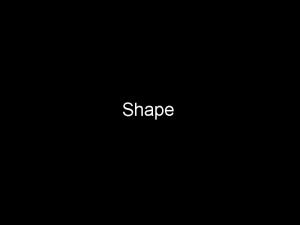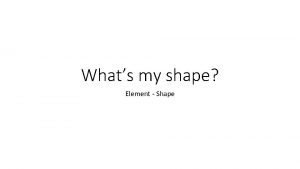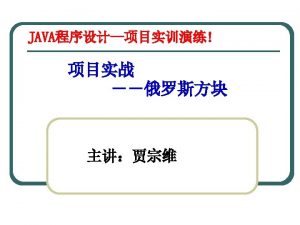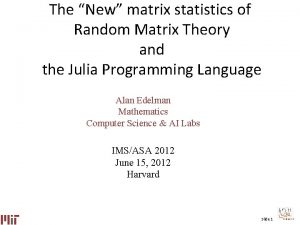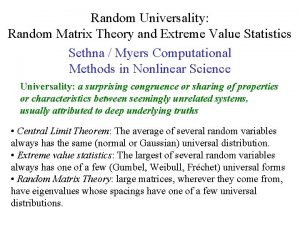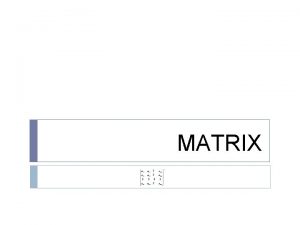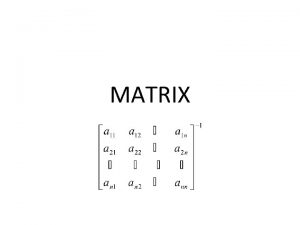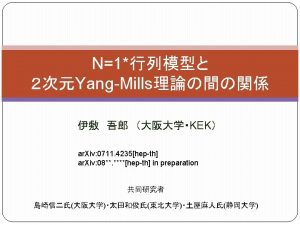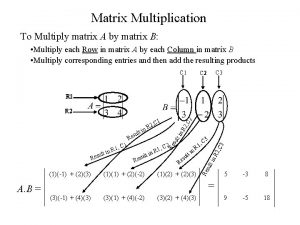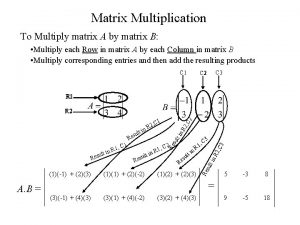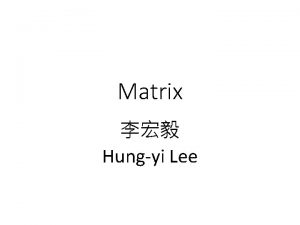Random Matrix Theory Random Matrix Theory Shape is
























































- Slides: 56

Random Matrix Theory •

Random Matrix Theory Shape is Captured by Empirical Spectral Density “Density” Of These Eigenvalues

Random Matrix Theory •

Random Matrix Theory • Spectral Density of Non-0 Eigenvalues

Random Matrix Theory •

Random Matrix Theory LSD: Primal & Dual Overlaid For Direct Comparison Notes: Area = 1 - Bar

• Discussed on 10/15/19, But Now Know Limit

Clusters in data Common Statistical Task: Find Clusters in Data • Interesting sub-populations? • Important structure in data? • How to do this? PCA & visualization is very simple approach There is a large literature of other methods (will study more later)

PCA to find clusters PCA of Mass Flux Data: PC 1 is Height Variation Mean Captures Mountain Shape Impression Enhanced By Smooth Histogram Are Clusters “Really There”? Discovery? Noise Artifact? Scores Suggest 3 Clusters

Statistical Smoothing In 1 Dimension, 2 Major Settings: • Density Estimation “Histograms” • Nonparametric Regression “Scatterplot Smoothing”

Density Estimation E. g. • • Hidalgo Stamp Data Another histogram Smaller binwidth Suggests 2 modes? 2 factories making the paper?

Density Estimation E. g. • • Hidalgo Stamp Data Another histogram Smaller binwidth Suggests 6 modes? 6 factories making the paper?

Density Estimation Compare shifts with Average Histogram • For 7 mode shift • Peaks line up with bin centers • So shifted histo’s find peaks

Density Estimation Compare shifts with Average Histogram • For 2 (3? ) mode shift • Peaks split between bins • So shifted histo’s miss peaks This Is Why Histograms Were Not Used in Many Displays of 1 -d Dist’ns, Earlier in Course

Kernel Density Estimation Chondrite Data: • Sum pieces to estimate density • Suggests 3 modes (rock sources)

Kernel Density Estimation Recall Subdensities For Different Groups Black Curves have Area = 1 Use Same Window Width, So They Sum

Kernel Density Estimation Choice of kernel (window shape)? • Controversial issue • Want Computational Speed? • Want Statistical Efficiency? • Want Smooth Estimates? • There is more, but personal choice: Looks the Best, Gaussian Minimal Distracting Small Scale Noise • Good Overall Reference: Wand Jones (1994)

Kernel Density Estimation Choice of bandwidth (window width)? • Very important to performance Fundamental Issue: Which modes are “really there”?

Density Estimation How to use histograms if you must: • Undersmooth (minimizes bin edge effect) • Human eye is OK at “post-smoothing”

Statistical Smoothing 2 Major Settings: • Density Estimation “Histograms” • Nonparametric Regression “Scatterplot Smoothing”

Scatterplot Smoothing E. g. Bralower Fossil Data Prof. of Geosciences Penn. State Univ.

Scatterplot Smoothing E. g. • • • Bralower Fossil Data Study Global Climate Time scale of millions of years Data points are fossil shells Dated by surrounding material Ratio of Isotopes of Strontium Surrogate for Sea Level (Ice Ages)

Scatterplot Smoothing E. g. Bralower Fossil Data Differences in 4 th Decimal Place! No Parametric (e. g. Linear) Model Yet Clear Systematic Structure ~50 m Sea Level Diff. Humans on Earth ~1 mil. Years

Scatterplot Smoothing E. g. Bralower Fossil Data • Way to bring out structure: Smooth the data • Methods of smoothing? – – – Local Averages Splines (several types) Fourier – trim high frequencies Other bases … Also controversial

Scatterplot Smoothing E. g. Bralower Fossil Data – some smooths

Scatterplot Smoothing •

Scatterplot Smoothing •

Scatterplot Smoothing • Kernel Weighted Fréchet Mean

Scatterplot Smoothing • Goldilocks Smoothing Levels Recommended For Manual Window Choice Thanks to Brad Davis Too Small About Right Too Big

Scatterplot Smoothing •

Scatterplot Smoothing •

Scatterplot Smoothing •

Scatterplot Smoothing Local Polynomial Smoothing • What is best polynomial degree? • Once again controversial… • Advocates for all of 0, 1, 2, 3. • Depends on personal weighting of factors involved • Good reference: Fan & Gijbels (1995) • Personal choice: degree 1, local linear

Scatterplot Smoothing E. g. Bralower Fossils – local linear smooths

Scatterplot Smoothing Smooths of Bralower Fossil Data: • Oversmoothed misses structure • Undersmoothed feels sampling noise? • About right shows 2 valleys: – – – One seems clear Is other one really there? Same question as above… Needs “Statistical Inference”, i. e. Confirmatory Analysis

Kernel Density Estimation Choice of bandwidth (window width)? • Very important to performance Fundamental Issue: Which modes are “really there”?

Kernel Density Estimation Choice of bandwidth (window width)? • Very important to performance • Data Based Choice? • Controversial Issue • Many recommendations • Suggested Reference: Jones, Marron & Sheather (1996) • Never a consensus…

Kernel Density Estimation Choice of bandwidth (window width)? • Alternate Choice: – – – • Consider all of them! I. e. look at whole spectrum of smooths Can see different structure At different smoothing levels Connection to Scale Space E. g. Stamps data – – How many modes? All answers are there….

Kernel Density Estimation

Statistical Smoothing Fundamental Question For both of • Density Estimation: “Histograms” • Regression: “Scatterplot Smoothing” Which bumps are “really there”? vs. “artifacts of sampling noise”?

Si. Zer Background Scale Space – Idea from Computer Vision Goal: Teach Computers to “See” Modern Research: Extract “Information” from Images Early Theoretical work

Si. Zer Background Scale Space – Idea from Computer Vision • Conceptual basis: Oversmoothing = “view from afar” (macroscopic) Undersmoothing = “zoomed in view” (microscopic) Main idea: all smooths contain useful information, so study “full spectrum” (i. e. all smoothing levels) Recommended reference: Lindeberg (1994)

Si. Zer Background Fun Scale Space Views (of Family Incomes Data)

Si. Zer Background Fun Scale Space Views (Incomes Data) Spectrum Overlay

Si. Zer Background Fun Scale Space Views (Incomes Data) Surface View

Si. Zer Background Fun Scale Space Views (of Family Incomes Data) Note: The scale space viewpoint makes Data Dased Bandwidth Selection Much less important (than I once thought…. )

Si. Zer Background Si. Zer: • Significance of Zero crossings, of the derivative, in scale space • Combines: – – • • needed statistical inference novel visualization To get: a powerful exploratory + confirmatory data analysis method Main references: Chaudhuri & Marron (1999) Hannig & Marron (2006)

Si. Zer Background Basic idea: a bump is characterized by: • an increase • followed by a decrease Generalization: Many features of interest captured by sign of the slope of the smooth Foundation of Si. Zer: Statistical inference on slopes, over scale space

Si. Zer Background Si. Zer Visual presentation: • Color map over scale space: • Blue: slope significantly upwards (derivative CI above 0) • Red: slope significantly downwards (derivative CI below 0) • Purple: slope insignificant (derivative CI contains 0)

Si. Zer Background Si. Zer analysis of Fossils data:

Si. Zer Background Si. Zer analysis of Fossils data: • Upper Left: Scatterplot, family of smooths, 1 highlighted • Upper Right: Scale space rep’n of family, with Si. Zer colors • Lower Left: Si. Zer map, more easy to view • Lower Right: Si. Con map – replace slope by curvature • Slider (in movie viewer) highlights different smoothing levels

Si. Zer Background Si. Zer analysis of Fossils data (cont. ): Oversmoothed (top of Si. Zer map): • Decreases at left, not on right Medium smoothed (middle of Si. Zer map): • Main valley significant, and left most increase • Smaller valley not statistically significant Undersmoothed (bottom of Si. Zer map): • “noise wiggles” not significant Additional Si. Zer color: gray - not enough data for inference

Si. Zer Background Si. Zer analysis of Fossils data (cont. ): Common Question: Which is right? • Decreases on left, then flat (top of Si. Zer map) • Up, then down, then up again (middle of Si. Zer map) • No significant features (bottom of Si. Zer map) Answer: All are right • Just different scales of view, • i. e. levels of resolution of data

Si. Zer Background Si. Zer analysis of British Incomes data:

Si. Zer Background Si. Zer analysis of British Incomes data: • • Oversmoothed: Only one mode Medium smoothed: Two modes, statistically significant Confirmed by Schmitz & Marron, (1992) • Undersmoothed: many noise wiggles, not significant Again: all are correct, just different scales

Participant Presentation Wei Gu: A Heuristic Approach to Portfolio Optimization with Cardinality Constraints Nicole Kramer: Calling DNA Loops in Hi-C Data
 Random assignment vs random sampling
Random assignment vs random sampling Random assignment vs random selection
Random assignment vs random selection Aerodynamic shapes
Aerodynamic shapes Shape matching and object recognition using shape contexts
Shape matching and object recognition using shape contexts Shape matching and object recognition using shape contexts
Shape matching and object recognition using shape contexts Julia random matrix
Julia random matrix Random field theory
Random field theory Random field theory
Random field theory Square vs circle
Square vs circle Transpose of a matrix definition
Transpose of a matrix definition Addition and scalar multiplication of matrices
Addition and scalar multiplication of matrices Diagonal matrix
Diagonal matrix Semmelweis university faculty of medicine
Semmelweis university faculty of medicine Perpendicular matrix
Perpendicular matrix Dissimilarity matrix
Dissimilarity matrix What is unitary matrix
What is unitary matrix Filetype:pdf
Filetype:pdf Fluid matrix of blood
Fluid matrix of blood Graph theory
Graph theory Theories of mineralization of dentin
Theories of mineralization of dentin Oligopoly characteristics
Oligopoly characteristics Oligopoly game theory matrix
Oligopoly game theory matrix Oligopoly board game
Oligopoly board game Oligopoly game theory matrix
Oligopoly game theory matrix Ansoff matrix 1957
Ansoff matrix 1957 Cv matrix game theory
Cv matrix game theory Bfss matrix theory
Bfss matrix theory Conditional matrix grounded theory
Conditional matrix grounded theory Ansoff martix
Ansoff martix Functional matrix theory
Functional matrix theory Functional matrix theory
Functional matrix theory Random early drop
Random early drop Discrete random variable
Discrete random variable Karyotype
Karyotype Vray random color
Vray random color Sql server 2005 encryption
Sql server 2005 encryption Contoh soal fungsi distribusi kumulatif kontinu
Contoh soal fungsi distribusi kumulatif kontinu Notasi variabel acak
Notasi variabel acak Contoh discrete random variable
Contoh discrete random variable Random uncertainty
Random uncertainty Plasma panel display in computer graphics
Plasma panel display in computer graphics Higher physics uncertainties
Higher physics uncertainties Bagging vs random forest
Bagging vs random forest Combining random variables
Combining random variables Give me 6 random numbers
Give me 6 random numbers Random walk with drift
Random walk with drift Drunken sailor walk
Drunken sailor walk Poison distribution
Poison distribution Random moment time study
Random moment time study Bilangan acak dalam simulasi
Bilangan acak dalam simulasi Quantitative variable examples
Quantitative variable examples Matched pairs study
Matched pairs study Cipher
Cipher Kelebihan dan kekurangan simple random sampling
Kelebihan dan kekurangan simple random sampling Simple random sampling with replacement example
Simple random sampling with replacement example Panel sampling
Panel sampling Random sampling method in quantitative research
Random sampling method in quantitative research





